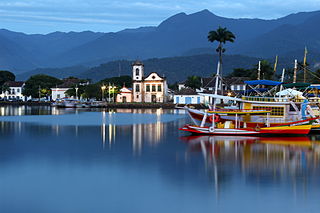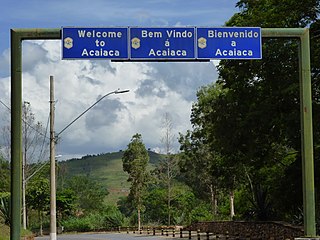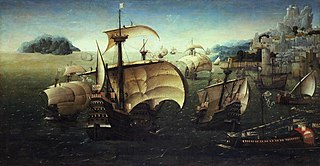Related Research Articles

Bartolomeu Dias was a Portuguese mariner and explorer. In 1488, he became the first European navigator to round the southern tip of Africa and to demonstrate that the most effective southward route for ships lies in the open ocean, well to the west of the African coast. His discoveries effectively established the sea route between Europe and Asia.

Paraty is a preserved Portuguese colonial (1500–1822) and Brazilian Imperial (1822–1889) municipality with a population of about 43,000. The name "Paraty" originates from the local Guaianá Indians' indigenous Tupi language, named for an abundant local fish native to the region. Paraty is located on the Costa Verde, a lush green corridor that runs along the coastline of the state of Rio de Janeiro, in Brazil. Paraty has become a tourist destination, known for its historic town center and the coast and mountains in the region. The historic center of the city, as well as four areas of the Atlantic Forest, were inscribed on the UNESCO World Heritage List in 2019 under the title "Paraty and Ilha Grande".

iSimangaliso Wetland Park is situated on the east coast of KwaZulu-Natal, South Africa, about 235 km (146 mi) north of Durban by road. It is South Africa's third-largest protected area, spanning 280 km (170 mi) of coastline, from the Mozambican border in the north to Mapelane south of the Lake St. Lucia estuary, and made up of around 3,280 km2 of natural ecosystems, managed by the iSimangaliso Authority. The park includes:
São José is Portuguese for Saint Joseph, and often refers to:
Nuno Tristão was a 15th-century Portuguese explorer and slave trader, active in the early 1440s, traditionally thought to be the first European to reach the region of Guinea. Legend has it that he sailed as far as Guinea-Bissau, however, more recent historians believe he did not go beyond the Gambia River).

Sofala, at present known as Nova Sofala, used to be the chief seaport of the Mwenemutapa Kingdom, whose capital was at Mount Fura. It is located on the Sofala Bank in Sofala Province of Mozambique. The first recorded use of this port town was by Mogadishan merchants. One possible etymology for Sofala is "go and cultivate" in the Somali language, showing the city as a hub for gold.

Portuguese is the official and national language of Brazil being widely spoken by most of the population. Brazil is the most populous Portuguese-speaking country in the world, with its lands comprising the majority of Portugal's former colonial holdings in the Americas.

Afonso Gonçalves Baldaia was a 15th-century Portuguese nautical explorer. He explored much of the coast of Western Sahara in 1435–1436 on behalf of the Portuguese prince Henry the Navigator. He would later become one of the first colonists of Terceira Island in the Azores.
Álvaro Fernandes, was a 15th-century Portuguese explorer from Madeira, in the service of Henry the Navigator. He captained two important expeditions, which expanded the limit of the Portuguese discovery of the West African coast, probably as far as the northern borderlands of modern Guinea-Bissau. Álvaro Fernandes's farthest point would not be surpassed for ten years, until the voyage of Alvise Cadamosto in 1456.
Afro-Portuguese(Afro portugueses or Lusoafricanos), African-Portuguese(Portugueses com ascendência africana), or Black Portuguese are Portuguese people with total or partial ancestry from any of the Sub-Saharan ethnic groups of Africa.
António de Saldanha was a Castilian-Portuguese 16th-century captain. He was the first European to set anchor in what is now called Table Bay, South Africa, and made the first recorded ascent of Table Mountain.

The Portuguese Indian Armadas were the fleets of ships funded by the Crown of Portugal, and dispatched on an annual basis from Portugal to India. The principal destination was Goa, and previously Cochin. These armadas undertook the Carreira da Índia from Portugal, following the maritime discovery of the Cape route, to the Indian subcontinent by Vasco da Gama in 1497–99.
The Fifth India Armada was assembled in 1503 on the order of King Manuel I of Portugal and placed under the command of Afonso de Albuquerque. It was Albuquerque's first trip to India. It was not a particularly successful armada - navigational mistakes scattered the fleet on the outward journey. Ships spent much time looking for each other and several ended up travelling alone.
The Fort of Má Ferramenta, near the port of the civil parish of São Mateus da Calheta, municipality of Angra do Heroísmo, along the southern coast of the Portuguese island of Terceira, in the archipelago of the Azores. Located in a dominant position over this coastal stretch of coast that sheltered anchored ships, it was a fortification used as a defence against attacks from pirates and corsairs, that frequented the waters of the mid-Atlantic.

The História trágico-marítima is a famous 18th-century collection of narrative accounts of the travails and wrecks of several Portuguese ships, principally carracks (naus) on the India run between 1552 and 1602, and the oft-harrowing stories of their survivors.
St Lucia is a settlement in Umkhanyakude District Municipality in the KwaZulu-Natal province of South Africa. The small town is mainly a hub for the iSimangaliso Wetland Park.

Manuel de Mesquita Perestrelo was a Portuguese navigator and cartographer.

São Bento, commanded by captain Fernão de Álvares Cabral, the son of Pedro Álvares Cabral, was a Portuguese carrack of 900 tons wrecked in April 1554 near the mouth of the Msikaba River, midway between Port Edward and Port St. Johns on the Transkei coast of South Africa. The ship had left Cochin on 1 February 1554 and was en route to Lisbon with a cargo of spices, coconuts, silks, porcelain, cornelian beads, cotton cloth and other luxury goods. There are no hull remains at the site.

Portugal–South Africa relations refer to the current and historical relationship between Portugal and South Africa. Nowadays the two countries have solid relations, with South Africa representing a major partner for Portugal amongst AU members.

Diogo Afonso was a Portuguese explorer.
References
- ↑ Gomes de Brito, Bernanrdo (1735). HISTORIA TRAGICO-MARITIMA Em que se escrevem chronologicamente os Naufragios que tiveraõ as Naos de Portugal, depois que se poz em exercicio a Navegação da India, Volume 1 (PDF) (in Portuguese). Lisbon: Officina da Congregação do Oratorio. p. 109. Archived from the original (PDF) on 11 November 2014. Retrieved 11 November 2014.
- ↑ Xavier Botelho, Sebastião (1835). Memoria estatistica sobre os dominios portuguezes na Africa Oriental, Volume 1 (in Portuguese). Lisbon: Typ. de José Baptista Morando. p. 77. Retrieved 11 November 2014.
See Years in South Africa for list of References